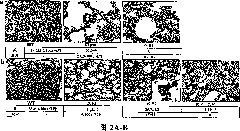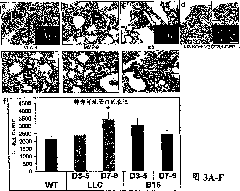Use of vascular endothelial growth factor receptor 1+ cells in treating and monitoring cancer and in screening for chemotherapeutics
A growth factor receptor, vascular endothelium technology, applied in the application of vascular endothelial growth factor receptor 1+ cells in the treatment and monitoring of cancer and in the screening of chemotherapy drugs, can solve the problem of unclear precise role of tumor metastasis and other issues
- Summary
- Abstract
- Description
- Claims
- Application Information
AI Technical Summary
Problems solved by technology
Method used
Image
Examples
preparation example Construction
[0054] Methods for preparing polyclonal antibodies are also well known. Usually, vascular endothelial growth factor receptor 1 can be + Subcutaneous administration of New Zealand white rabbits (which had previously been bled to obtain preimmune serum) produced such antibodies. Antigen was injected at 6 different sites with a total volume of 100 μl per site. Each injected material contained pluronic polyol, a synthetic surfactant adjuvant, or ground acrylamide gel containing protein or polypeptide after SDS polyacrylamide gel electrophoresis. Rabbits were bled 2 weeks after the first injection, and then boosted 3 times with the same antigen regularly every 6 weeks. Serum samples were collected 10 days after each booster immunization. Polyclonal antibodies are then recovered from the serum by affinity chromatography using the corresponding antigen-capture antibodies. Finally, rabbits were anesthetized with 150 mg / Kg IV pentobarbital. The above and other methods for producin...
Embodiment 1
[0087] Wild-type C57B1 / 6 mice were lethally irradiated (950 rads) and then transplanted with 1×10 6 β-galactosidase + or GFP + BM cells (Rosa-26 mice) (Lyden et al., "Impaired Recruitment of Bone-marrow-derived Endothelial and Hematopoietic Precursor Cells Blocks Tumor Angiogenesis and Growth" and Growth), "Nat. Med. 7: 1194-1201 (2001), which is hereby incorporated by reference in its entirety). After 4 weeks, mice were intradermally injected with 2×10 6 LLC (ATCC) or B-16 cells (ATCC).
Embodiment 2
[0088] Tissues and femurs were fixed in 4% paraformaldehyde (PFA) for 4 hours. Samples were stained in X-gal solution at 37°C for 36 hours, see Tam et al., "The Allocation of Epiblast Cells to the Embryonic Heart and other Mesodermal Lineages: The Role of Ingression and Tissue Movement during Gastrulation" Other mesoderm lineages: role of inward migration and tissue motility during gastrulation)," Development. 124: 1631-1642 (1999), which is hereby incorporated by reference in its entirety. X-gal stained tumors and BM were embedded as described in: Lyden et al., "Impaired Recruitment of Bone-marrow-derived Endothelial and Hematopoietic Precursor Cells Blocks TumorAngiogenesis and Growth can block tumor angiogenesis and growth)," Nat. Med. 7: 1194-1201 (2001), which is hereby incorporated by reference in its entirety.
PUM
 Login to View More
Login to View More Abstract
Description
Claims
Application Information
 Login to View More
Login to View More - R&D
- Intellectual Property
- Life Sciences
- Materials
- Tech Scout
- Unparalleled Data Quality
- Higher Quality Content
- 60% Fewer Hallucinations
Browse by: Latest US Patents, China's latest patents, Technical Efficacy Thesaurus, Application Domain, Technology Topic, Popular Technical Reports.
© 2025 PatSnap. All rights reserved.Legal|Privacy policy|Modern Slavery Act Transparency Statement|Sitemap|About US| Contact US: help@patsnap.com



